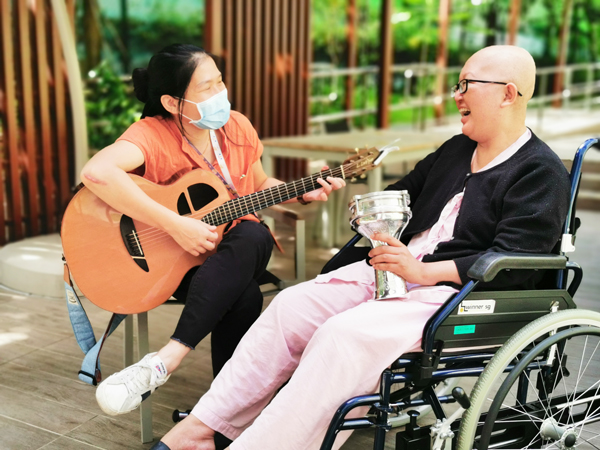Helping the dying to live their final journey well
published by Business Times on July 8, 2021The pandemic has challenged Assisi Hospice to refine service delivery and reallocate finite resources, while validating earlier decisions to grow home care services, says CEO Choo Shiu Ling.

2020 was a year that demanded much from the Assisi Hospice team – sacrifice, adaptability and resilience. Yet, “thankfulness beyond measure” are the words chief executive officer Choo Shiu Ling reaches for to sum up the experience of leading her palliative care team through the pandemic.
A spike in demand for the non-profit’s inpatient, home care and day care services ran up against fluctuations in manpower due to border closures, quarantines and mandatory stay-home notices. The distancing, separation and caution central to the pandemic response stood in direct opposition to the nearness, touch and comfort that marks care for the dying.
Still, Ms Choo says, she has been thankful for the adaptability of the Assisi team – staff and volunteers alike. “They somehow managed to provide love and care, often with amazing joy and lightness, even as they faced their own challenges.” And, weathering the crisis has affirmed the direction the hospice was moving in, while leaving an indelible mark on its future growth trajectory.

Clarity of shared purpose
For one, the Covid-19 pandemic has underscored the importance of clear and shared organisational purpose, values and culture, says Ms Choo.
“There’s the understanding that our entire purpose is to serve patients and their families. We are an organisation very driven by values. We believe that we are all created equal and that the final journey is also our final opportunity to express the importance of our shared humanity, to express the fact that everyone, regardless of how your life has been lived, is of great value.”
Even outside times of crises, end-of-life care is complex. “When we deal with someone at the end of life, and their families, the complexity of psychosocial issues and needs is dramatic. Because it’s the culmination of a life that has been lived and all the choices that have been made. That does require collective wisdom. No one single health professional can do that… we work very closely as an interdisciplinary team,” she says.
The Catholic charity’s staff of 240 – which includes doctors, nurses, medical social workers, counsellors, physiotherapists, occupational therapists, music and art therapists, pharmacists, speech therapists, pastoral care staff – cared for a total of 2,711 patients last year. 52 per cent of these patients fell into the lowest income bracket when means-tested.
“The economic and psychosocial impact of the pandemic has intensified the challenges. In addition, navigating healthcare needs and the healthcare system during pandemic times added stress on caregivers. Our staff not only faced their own challenges on the home front but had to also face significantly increased needs of our patients and families,” says Ms Choo.
Clarity of shared purpose allowed Assisi’s leadership to boil decisions down to “how to best take care of staff and best meet the needs of patients”. “We placed a priority on staff safety and well-being, adjusted our team structure, and recalibrated clinical and corporate processes,” she adds.
Swift shifts
Many of those changes had to be swift. Staff and committed volunteers took on more responsibilities and bore the burden of more stringent infection control measures so that the hospice could function almost at “business as usual” for patients and families.
This allowed Assisi to take on 25 per cent more inpatient admissions in 2020 compared to the year before – 939 patients in all. The rise in demand for the hospice’s inpatient services trickled down in part from the acute hospitals, which needed to free up beds to care for Covid-19 patients and others needing acute care.
But it was also because when there had been very strict visitor restrictions at most healthcare institutions last year, Assisi was able to open to caregivers’ visits 24/7 with a cap on the number of visitors at a time.
One reason was that 60 per cent of the beds in Assisi’s purpose-built six-storey building in the Thomson area are in single rooms – sunlit, with views of greenery – allowing for patients’ loved ones to visit safely and even stay overnight. “For our patients and families dealing with the end of life, they have just days, weeks or short months. There is no ‘do over’ or later time.”
More than half of the patients Assisi served last year, though, were cared for in their own homes. This home care arm is one that Assisi has intentionally expanded over the last three years – a strategy that 2020 affirmed was wise.
“By growing the capabilities and capacity of our home care team, we have been able to take care of more patients (1,672 last year) in their home environment, even when faced with pandemic uncertainties and the impact on manpower,” she said. This has validated the hospice’s channelling of more resources towards home care services.
Circumstances also catalysed more innovation. Assisi served 100 day care patients last year – patients who are well enough to stay home but head to the centre regularly for therapeutic programmes.
“The pandemic has challenged us to refine our service delivery, find new ways to engage and make best use of our finite resources,” Ms Choo said. When day care centres had to close during the circuit breaker, staff swiftly switched to engaging patients via therapeutic care packages, rehabilitative video programmes and art and therapy videos, as well as home visits when needed.
Growing need for palliative care
Over the past four years, Assisi has tripled the number of patients it serves. As caring for families – not solely the terminally ill patients – is central to Assisi’s purpose, Ms Choo has plans to expand the hospice’s grief and bereavement programme to support bereaved families and caregivers as well, even as numbers grow.
Assisi is also developing an IT system to integrate patients’ clinical information across the day care, inpatient and home care services.
Mobile applications to provide the home care teams, in particular, with up-to-date patient clinical information on-the-go will be rolled out later this year.
Beyond providing better care to its own patients, Ms Choo sees a broader role for Assisi in palliative care.
“We hope to become a clinical centre for palliative care education and training in a community setting, both locally and (in the) region,” she says. The goal is to develop quality palliative care education programmes to equip healthcare professionals caring for persons with serious illnesses in the community.
At the rate Singapore’s population is ageing, the need for such healthcare professionals is a pressing one. Life-limiting illness such as cancer and end-stage organ failure are predominantly illnesses of the elderly. “Patients are also living longer with serious life-limiting illnesses because of medical advances that can prolong life without always improving the quality of life,” Ms Choo observes.
Medical devices and therapeutics have raised the life expectancy of those with end-stage organ failure, so that while dying took days or short weeks, it may now take months to years, preceded by a period of progressive disability.
There has been significant progress in palliative care over the past two to three decades, Ms Choo says. Palliative care services are now available in all public hospitals, palliative care beds are in almost all the community hospitals, and there are seven home hospice services, two inpatient hospices and several day hospices. The private sector has started offering such services too.
Still, there are ways in which palliative care can be improved. Ms Choo sees the need for increasing recognition that palliative care is for all serious life-limiting illnesses, whether these are cancer or non-cancer conditions. Healthcare professionals would benefit from training in basic palliative care, with one significant gap at the moment being in the nursing home sector here, she says.
Other possibilities for change include a mindset change that associates palliative care with “living well” rather than with terminal care and “giving up”. This would allow for palliative care to be introduced early, alongside standard disease-specific care. Much evidence has emerged over the past decade to show the benefits of early palliative care in terms of quality of life and mental health.
While demand for palliative care services will no doubt rise, it remains a highly specialised and niche area of care.
Belonging to the community
As a niche charity, Assisi relies heavily on community support – donations – and government grants. Financial sustainability is key to enabling the hospice to carry out its mission, which is why its board formed a resource strategy taskforce in 2018 and produced a plan to secure long-term funding sustainability.
“Our finance committee and investment committee have also been hard at work with the management team to help ensure good financial stewardship of the resources that we have been blessed with,” says Ms Choo.
Though 2020 was a difficult year for fundraising – income from fundraising activities fell from S$8.44 million in 2019 to S$5.43 million in 2020 – Assisi was indeed blessed with a rise in general donations, from S$5.7 million in 2019 to S$6.98 million in 2020.
Total income across its funds also rose from S$36.33 million in 2019 to S$50.69 million in 2020, thanks to an increase in government grants. In April 2020, the Ministry of Health announced the Inpatient Hospice Palliative Care Service which extends MediShield Life coverage to Assisi’s patients and means that those who qualify for the maximum government subsidy would pay S$17 a day.
For Assisi, which accepts patients entirely based on their medical needs – financial considerations are entirely removed from the process of admission – this supports their inpatient operating costs significantly. “We offer all patients the same access to care – whether you are very well off or the poorest of poor. My clinical team doesn’t see that. They will allocate a single room to the person who needs it most,” says Ms Choo.
Part of ensuring sustainability includes advocacy of palliative care through outreach and fundraising events, and ensuring transparency and good governance. This serves to build the community’s trust. The hospice has received the Charity Transparency Award every year since it was introduced in 2016 by the Charity Council to recognise charities with good disclosure practices, and won the Charity Governance Award in 2019.
Having a clear focus on purpose – a reverence for life and posture of service that shapes the compassionate and personalised care Assisi seeks to provide its patients – affords the team space to trust that they will continue to receive the resources they need.
“We fundamentally see ourselves as part of the community, and here to serve the community. Should we really understand what patients and families need, really understand what the community needs, it should be true that the community would be willing to support us,” Ms Choo adds.
Dentons Rodyk is proud and privileged to have supported Assisi Hospice in the pursuit of its mission to provide compassionate, personalised and quality palliative care to adults and children with life-limiting illnesses. The firm has guided Assisi Hospice in a variety of matters over the years and also acted as advisers for the Franciscan Missionaries of the Divine Motherhood and Mount Alvernia Hospital. With over 12,000 lawyers, in over 200 locations, Dentons is best positioned to deliver specific and tailored advice to aid organisations in their commercial and humanitarian efforts. We are grateful to have been a part of Assisi Hospice’s growth story as we celebrate our own 160th anniversary.
Click Here to view full article

